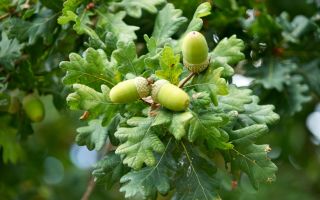Content
Oak is called a symbol of courage. The sturdy, mighty tree is one of the most revered. In particular, under the sacred Oak, important events took place among the Slavs, among which a wedding and courts were distinguished. The tree has not only magical, but also healing qualities. Science knows the beneficial properties of oak leaves and contraindications.
What it looks like and where it grows
In ancient times, half of all European forests were oak forests. The breed was used as building materials and firewood. Due to felling, the area of oak growth has significantly decreased and is currently about 3% (in Europe).
The tree has several varieties. Common oak is common in Russia. It is also called petiolate because of its long stalks. This is a forest-forming species that is found in the strip of coniferous and deciduous forests, mainly in the European part. It grows with the following crops:
- elm;
- Linden;
- maple;
- ash;
- spruce.
Oak usually forms pure stands only in river floodplains. He prefers the following soils:
- moderately humid forest gray loams;
- degraded chernozems;
- burozems (in the mountains);
- alluvial soils.
Oak can also be found in the region of Western Europe and the Ural Range. This is a light-loving tree, demanding on soils. The culture does not tolerate excessively wet soil.
Culture has its own characteristics. A large tree has a powerful crown and a powerful trunk. Height can reach 40 cm, and age - 2000 years. However, on average, a tree lives for about 400 years. The growth (in thickness) continues throughout the entire period of life. Growth in height stops when the tree reaches 200 years.
The crown of the oak is formed by thick and spreading branches. The bark is durable. A mature tree can be distinguished by the dark color of the trunk. Large oblong leaves have rounded teeth. They bloom closer to June. Flowers are represented by hanging earrings. They reach a length of 3 cm.
The fruits are elongated acorns that pigs and wild boars eat. They grow up to 5 cm. Acorns are green in summer. In the autumn months, the fruits gradually turn yellow and then fall off. Nice caps have a smooth surface. Inside are bitter wedges.
Oaks bloom at the age of 40, and sometimes 60 years. It is noteworthy that this period coincides with the appearance of shoots. Thus, flowering and leaf opening occurs in May.
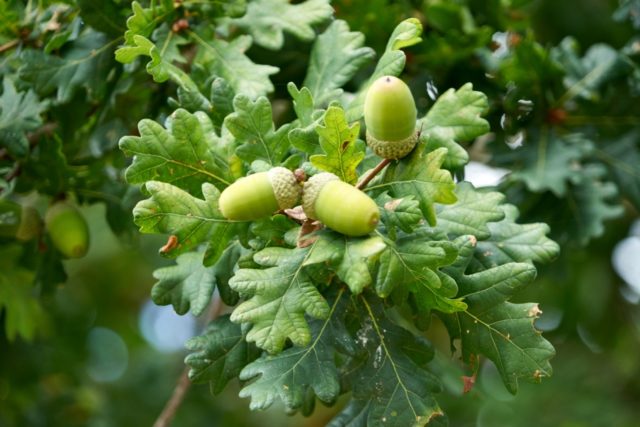
The chemical composition of oak leaves
The culture is used in folk medicine. This is due to the presence of valuable substances in the bark, foliage and acorns. From raw materials, drugs are made that have a positive effect on the human body.
The benefits of oak leaves for humans are related to their chemical composition. The plates are rich in the following components:
- quercetin;
- quercitrin;
- pentosans;
- tannins.
Why are oak leaves useful?
The raw material is intended for indoor and outdoor use.The use of tools made on the basis of blanks contributes to:
- healing of cuts and small wounds, ulcers;
- improving the functioning of the stomach, as well as eliminating gastritis and colitis;
- treatment of gynecological pathologies;
- decrease in pressure;
- strengthening blood vessels by reducing the risk of cholesterol plaque formation.
Oak leaves are distinguished by the following effects:
- anti-inflammatory;
- calming;
- antihelminthic;
- hemostatic.
Preparation and application methods
Raw materials are used both for the treatment and prevention of gynecological and skin diseases, pathologies of the digestive system. Dosage forms differ in a variety of applications.
Tea
The drink is suitable for daily consumption. However, tea made from oak leaves can be not only beneficial, but also harmful. It is not advised to exceed the recommended dosages so as not to provoke disturbances in the work of the digestive tract.
To make tea, pour a half liter of boiling water over several sheets. Raw materials are taken both fresh and dried. The remedy is insisted for several hours.
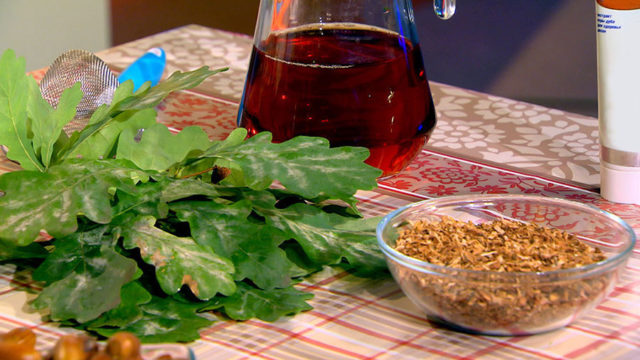
Decoction
The dosage form is intended for external use. Mix one tablespoon of dry oak leaves with the same amount of bark, pour over water (200 ml). The composition is boiled for three minutes, cooled and filtered.
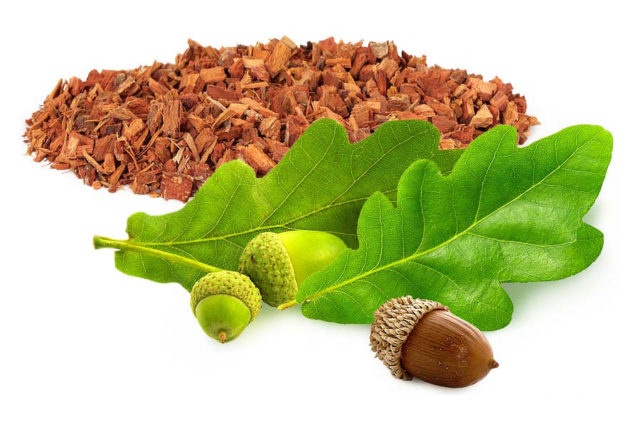
The use of oak leaves in folk medicine
Raw materials are actively used in folk medicine. This is due to the beneficial effects of oak leaves in the composition of decoctions and infusions.
To improve the functioning of the digestive system
To prepare a healthy drink, take 20 g of raw materials (leaves and bark) and pour 200 ml of boiling water. The composition is covered and simmered for 30 minutes in a water bath. Then the resulting broth is cooled and filtered. It is necessary to restore the previous volume of 200 ml by adding boiled water.
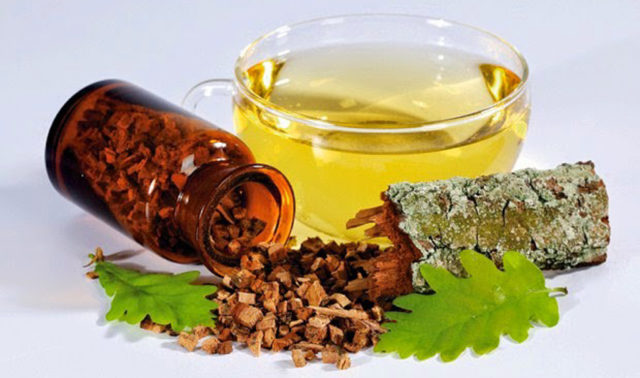
For diseases of the oral cavity
Gargling with a decoction of oak leaves is considered an effective way to eliminate gum and throat diseases. The tool is effective for the following pathologies:
- stomatitis;
- gingivitis;
- tonsillitis.
Oak leaves and bark are mixed in equal proportions. Take 100 ml of water for one tablespoon. The mixture is boiled for several minutes and then filtered. The resulting product is used to rinse the mouth.
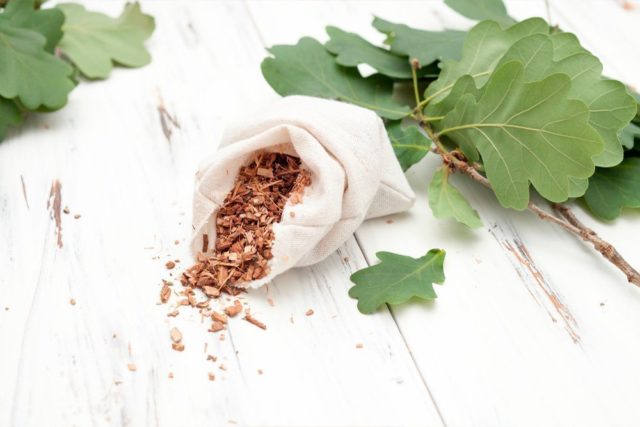
Sweaty feet
With the regular appearance of an unpleasant odor, baths are made. For two tablespoons of raw materials (bark and oak leaves) take a glass of water. The composition must be boiled for two minutes and insisted.
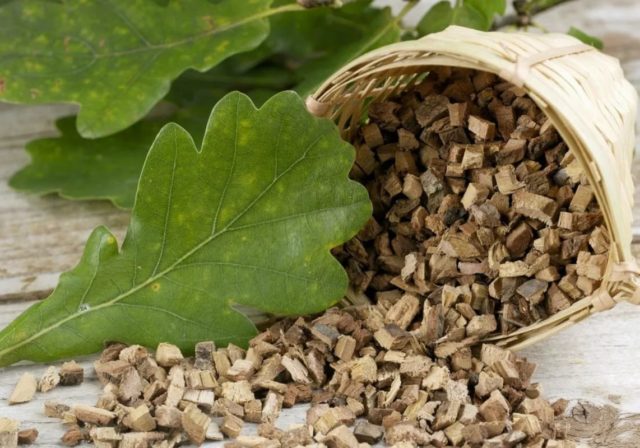
From hemorrhoids
The use of infusions in the form of enemas is recommended in the presence of nodes. To prepare the drug, four crushed leaves and a small spoonful of bark are poured into a glass of boiling water. The mixture is infused for an hour. The resulting composition can be diluted with water before use.
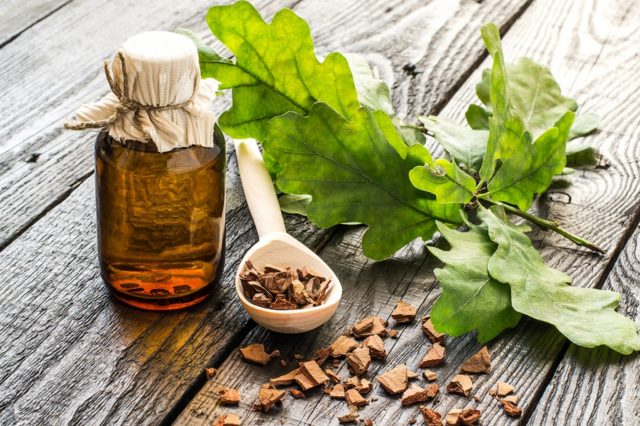
With diseases of the excretory system
It is advisable to treat pathologies of the kidneys, urinary tract with agents including oak leaves and bark. Raw materials are mixed using a ratio of 10: 1, poured into a glass of boiling water. The drink is consumed after cooling once a day in the morning.
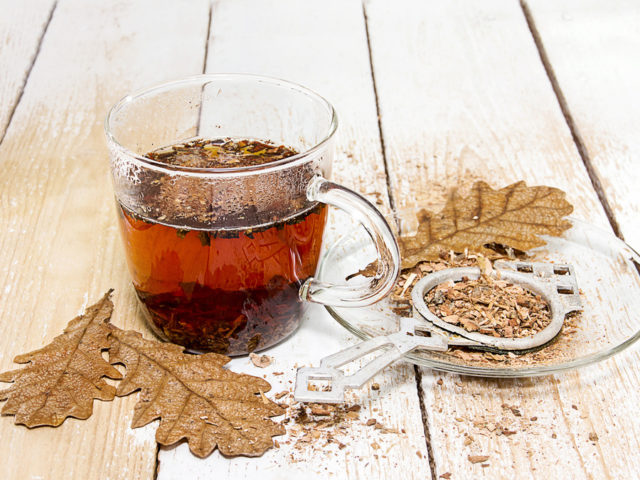
From varicose veins
In case of vein disease, drugs are made for external use. A liter of boiling water is poured into 20 young leaves and 40 g of oak bark. The product is left to infuse for three hours, after which it is poured into the bath. Legs float for 20 minutes.
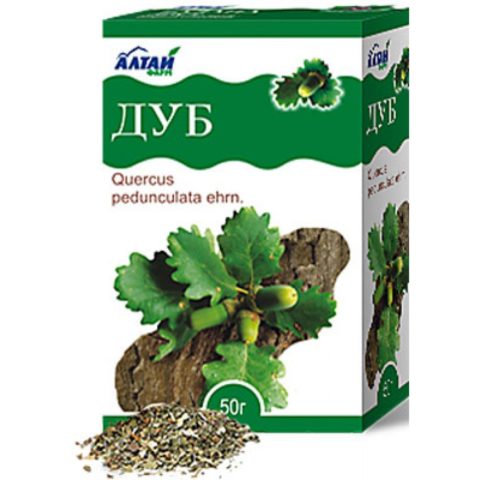
Contraindications
Compliance with the proportions indicated in the recipes is essential. Exceeding the permissible dosages can cause disruption of the digestive tract. Adverse reactions include nausea and vomiting, diarrhea.
Internal use of products made from oak shoots is strictly prohibited in childhood. Contraindications also include manifestations of hypersensitivity.
Collection and procurement
Young oak leaves have healing properties. Shoots are harvested in mid-summer (June, July). During this period, they contain the maximum amount of nutrients.
Young trees are suitable for harvesting raw materials, which have a height of up to 5 m. They are distinguished by flexible branches and strong shoots. It is advisable to cut the leaves with them and tie them into a kind of brooms. They are hung to dry in a dark place. Raw materials are stored for about a year.
During this period, it is important to provide fresh air to the dried leaves. The sun's rays provoke the loss of nutrients.
Conclusion
The beneficial properties of oak leaves and contraindications indicate the need for careful use of medicines containing raw materials. Young shoots have been used for therapeutic purposes since ancient times. They include many active ingredients that have a beneficial effect on the condition of the skin, the genitourinary system, and the digestive tract.

